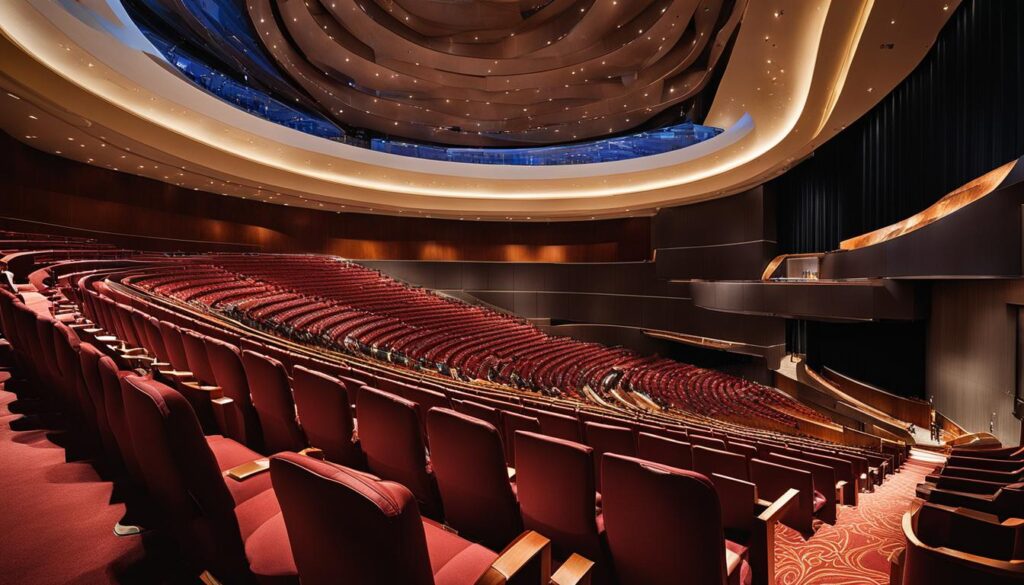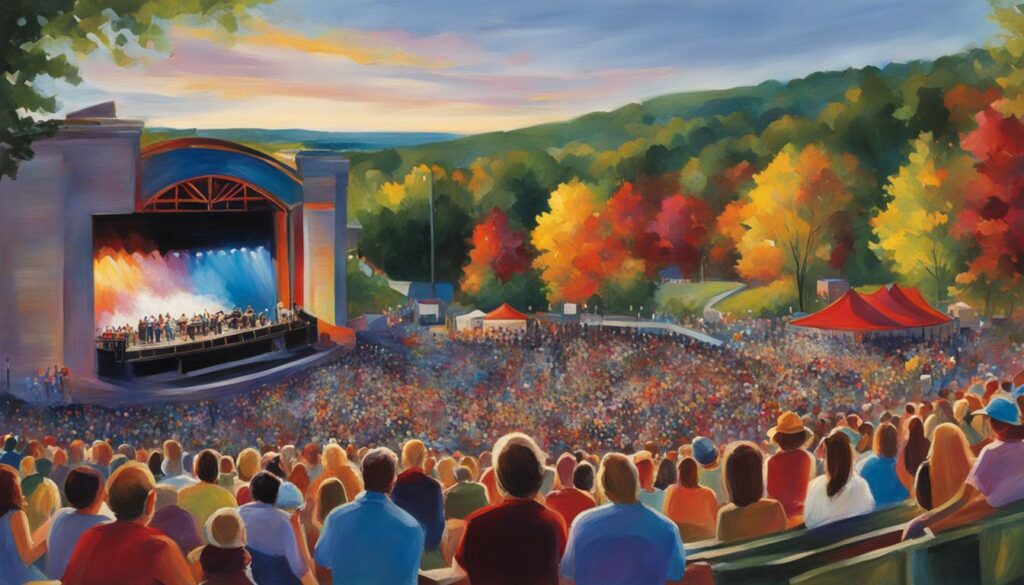Welcome to my blog post where I will be delving into the fascinating world of performing art studios. If you’ve ever wondered what exactly a performing art studio is and how it contributes to artistic development, then this is the article for you. Whether you’re interested in professional training, creative studios, or simply want to explore the realm of artistic expression, we’ll uncover all the answers you seek.
Performing art studios are dedicated spaces where artistic creation and development thrive. These dynamic hubs offer a wide range of art forms, including dance classes, theatre workshops, music lessons, and visual arts programs. They provide not only training but also a nurturing environment for individuals to enhance their skills and foster their artistic passion. Additionally, performing art studios serve as platforms for community performances, where the talents and creativity of artists are showcased and celebrated.
Key Takeaways:
- A performing art studio is a dedicated space for artistic creation and development.
- Various art forms, such as dance, theatre, music, and visual arts, find their home in these studios.
- Performing art studios offer professional training and education, fostering artistic development.
- Community performances are a significant part of these studios, showcasing the talents of artists.
- Performing art studios provide an environment for artists to enhance their skills and foster their artistic passion.
The History of Artist’s Studio
During the Renaissance period, artists sought to establish their own creative spaces away from the influence of the Church. These spaces, known as artist’s studios, provided artists with the freedom to pursue their artistic visions and develop their techniques. The concept of the bottega, a workroom for art-making, and the studiolo, a contemplative study, emerged during this period.
The bottega was a bustling workshop where artists would collaborate with apprentices and fellow artists to create masterpieces. It was a place of artistic motivation and skill development. The studiolo, on the other hand, was a more intimate space for individual reflection and contemplation. It served as a sanctuary for artists to immerse themselves in their creative process and explore new ideas.
These Renaissance studios played a crucial role in the development of art during this period. Artists such as Leonardo da Vinci, Michelangelo, and Raphael utilized their studios to perfect their techniques, experiment with new materials, and create iconic works of art. The artist’s studio became a sanctuary for artistic expression and a place where creativity flourished.
Inspiring Quote:
“The artist’s studio is a portal into their creative world, a space where imagination takes flight and masterpieces come to life.” – Art critic Jane Johnson
| Artistic Motivation | Bottega | Studiolo |
|---|---|---|
| The artist’s studio served as a place of artistic motivation, where artists would spend hours perfecting their craft and creating masterpieces. | The bottega was a collaborative workroom in which artists would collaborate with apprentices and fellow artists to create art. | The studiolo was a contemplative study where artists could reflect and explore new ideas in a more intimate space. |
| The studio allowed artists to pursue their artistic visions and develop their techniques. | It provided a bustling environment for skill development and artistic collaboration. | It served as a sanctuary for individual reflection and creative exploration. |
| Artists such as Leonardo da Vinci, Michelangelo, and Raphael utilized their studios to create iconic works of art. | The bottega was a place where creativity flourished and new artistic ideas were born. | The studiolo allowed artists to immerse themselves in their creative process and explore new ideas. |
Today, the legacy of the Renaissance artist’s studio lives on. The concept of the artist’s studio as a space for artistic exploration and creation continues to inspire artists around the world. From contemporary studios to historical sites preserved for their artistic significance, these spaces offer a glimpse into the creative process and the immense dedication required to be an artist.
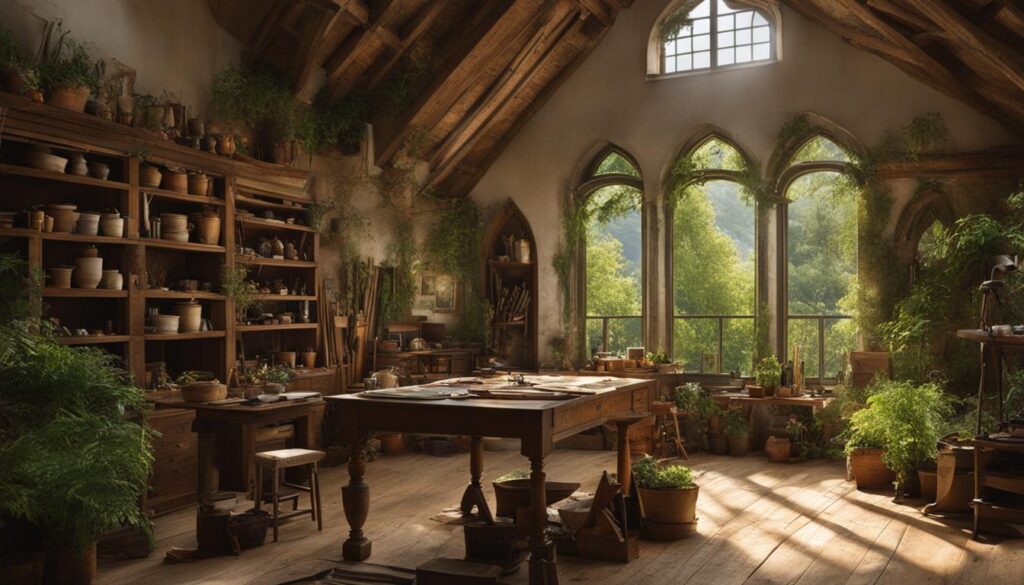

Exploring the history of the artist’s studio allows us to appreciate the importance of creative spaces in fostering artistic development. Whether it’s a bustling bottega or an intimate studiolo, the artist’s studio remains a symbol of inspiration and artistic expression.
The Developments of the 19th Century
In the 19th century, the artist’s studio went through significant transformations as a result of various developments. One notable change was the establishment of the French Academy, which had a profound impact on the art world. The French Academy’s exhibition program became a pivotal platform for artists to showcase their works and gain recognition. However, this academic system also imposed strict rules and standards, which led many artists, particularly those associated with the avant-garde movement, to rebel against it.
The avant-garde artists sought new ways to express their creativity and break away from traditional artistic norms. They challenged the established notions of art and experimented with unconventional techniques and subject matters. These artists pushed the boundaries of artistic expression and paved the way for new artistic movements.
The industrial revolution also had a significant influence on the artist’s studio. With new technological advancements and the emergence of modern society, artists were no longer confined to traditional studio spaces. They began exploring new environments and embracing the outdoors, often painting en plain air to capture the essence of nature and everyday life. This shift allowed for a more constant production of artworks and brought a fresh perspective to the art world.
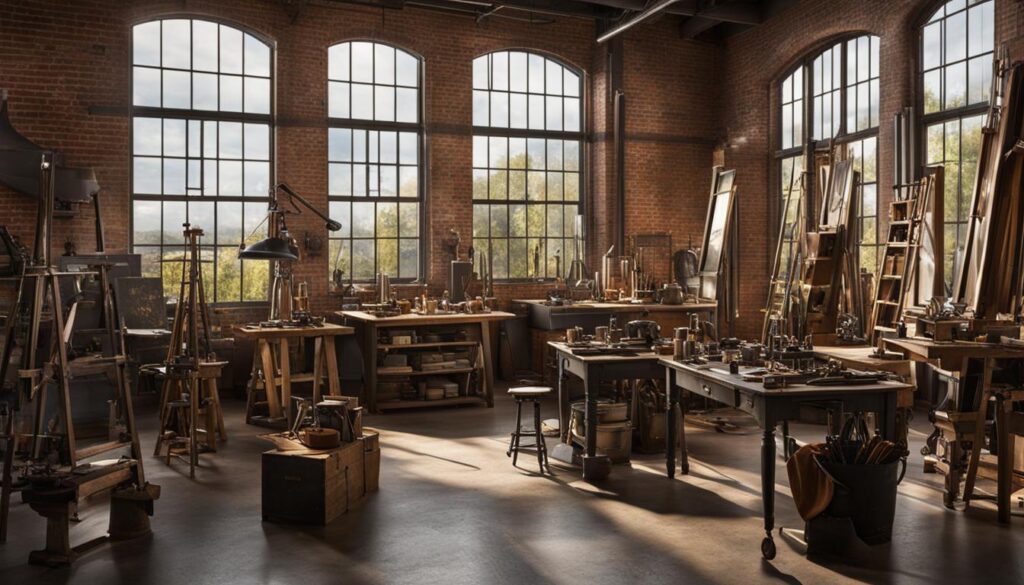

Table: Artists of the Avant-Garde Movement
| Artist | Artistic Style | Notable Works |
|---|---|---|
| Pablo Picasso | Cubism | Les Demoiselles d’Avignon, Guernica |
| Claude Monet | Impressionism | Water Lilies, Haystacks |
| Vincent van Gogh | Post-Impressionism | The Starry Night, Sunflowers |
| Edgar Degas | Realism, Impressionism | The Dance Class, The Absinthe Drinker |
The developments of the 19th century marked a significant turning point in the history of the artist’s studio. The rebellion against academic norms, the embrace of new environments, and the constant production of artworks brought about a wave of creativity and innovation that continues to inspire artists to this day.
Artist Studios Today
Artist studios have evolved beyond being just spaces for artistic creation. They have transformed into vibrant and dynamic creative spaces that serve multiple purposes. In addition to providing artists with a dedicated workspace, these studios have become exhibition spaces, allowing artists to showcase their work to the world.
Many artist studios have been transformed into single-artist museums, offering visitors a unique opportunity to immerse themselves in the world of a particular artist. These museums provide a curated experience, showcasing the artist’s body of work and giving insights into their creative process. Examples of such single-artist museums include Andy Warhol’s Factory and the studios of contemporary artists like Damien Hirst and Jeff Koons.
Visiting an artist studio or a single-artist museum is an enriching experience that allows art enthusiasts to see beyond the finished artworks. It provides a glimpse into the environment in which the artist lived and worked, offering a deeper understanding of their creative journey. These spaces often include personal artifacts, sketches, and unfinished works, giving visitors a sense of the artist’s artistic process and inspiration.
| Artist Studios Today | Location |
|---|---|
| Andy Warhol’s Factory | New York, USA |
| Damien Hirst’s Studio | London, UK |
| Jeff Koons’ Studio | New York, USA |
In addition to single-artist museums, artist studios today also serve as venues for exhibitions and events. They have become community hubs, hosting art shows, workshops, and cultural programs. These spaces foster artistic collaboration and serve as platforms for emerging artists to showcase their talent. With their versatile and dynamic nature, artist studios continue to be at the forefront of artistic innovation and expression.
Famous Artist Studios around the World
There are several famous artist studios around the world that offer a unique glimpse into the lives and works of iconic artists. These studios are not only historical sites but also provide a source of artistic inspiration, allowing visitors to immerse themselves in the artist’s environment. From the picturesque landscapes of the South of France to the bustling streets of Manhattan, these studios reflect the diverse creative spaces where artists found solace, inspiration, and brought their artistic visions to life.
Paul Cézanne’s Studio (Aix-en-Provence, France)
One of the most famous artist studios is that of Paul Cézanne, located in Aix-en-Provence, France. This picturesque studio is nestled in the countryside, surrounded by beautiful gardens and stunning landscapes that served as inspiration for many of Cézanne’s masterpieces. The studio has been preserved to maintain its authentic charm, showcasing Cézanne’s personal belongings, art materials, and unfinished works. Visitors can step into the world of this post-impressionist artist, gaining insight into his creative process and the environment that shaped his artistic vision.
Louise Bourgeois’ Studio (Chelsea, New York)
In the heart of Chelsea, New York, lies the studio of the renowned artist Louise Bourgeois. This spacious loft served as her creative sanctuary for over 30 years and witnessed the creation of her iconic sculptures and installations. The studio is an immersive experience, filled with the tools, materials, and personal artifacts that fueled Bourgeois’ artistic practice. Visitors can explore the intimate space where she worked and gain a deeper understanding of her exploration of themes such as femininity, memory, and vulnerability.
Edward Hopper and Keith Haring’s Studios (Manhattan, New York)
Manhattan, New York, is home to two iconic artist studios: Edward Hopper’s studio and Keith Haring’s Pop Shop. Edward Hopper’s studio, located in Greenwich Village, was where the renowned American realist painter created some of his most celebrated works. The studio has been preserved and allows visitors to step back in time, experiencing the atmosphere and inspiration that influenced Hopper’s iconic paintings. On the other hand, Keith Haring’s Pop Shop in SoHo was not just a studio but also a retail store that showcased his vibrant and bold artworks. The studio provided him with a platform to reach a wider audience and share his artistic vision with the world.
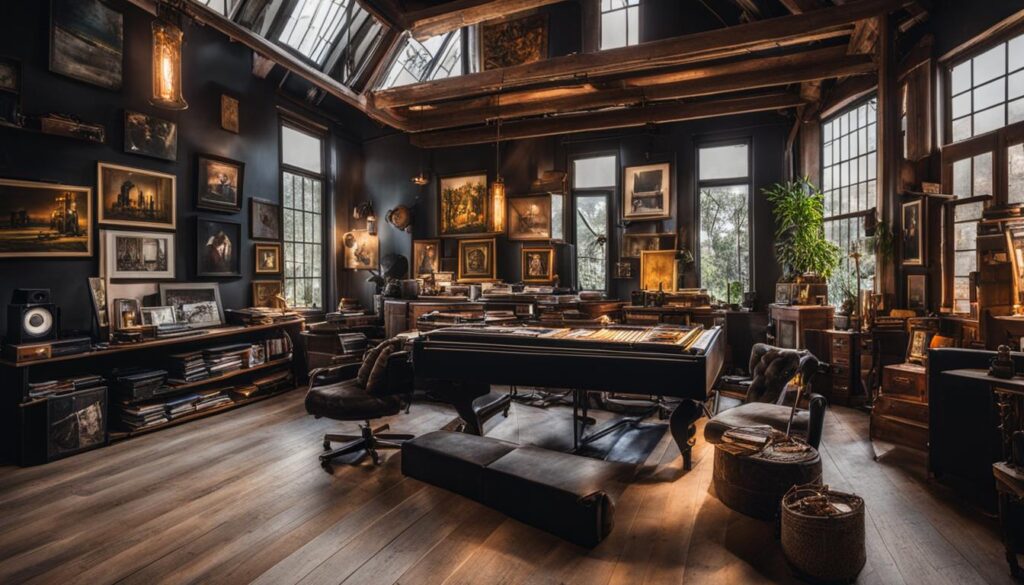

These famous artist studios are not only historical landmarks but also serve as reminders of the immense passion and dedication that artists pour into their work. They offer visitors a unique opportunity to connect with the art and creativity of renowned artists, as well as gain insight into the environments that shaped their artistic expressions. Whether it’s the serene landscapes of the South of France or the bustling streets of Manhattan, these studios continue to inspire and captivate art enthusiasts from around the globe.
Conclusion
As a professional copywriting journalist, I have explored the fascinating world of performing art studios and artist’s studios. These spaces are not only dedicated to artistic creativity, but also serve as platforms for artistic development and passion.
Performing art studios provide individuals with the opportunity to enhance their skills and receive professional training in various art forms. They nurture artistic creativity and passion by offering a dedicated space for artists to explore their talents and express themselves.
Similarly, the history of artist’s studios reflects the changing nature of art and the role of artists in society. From the Renaissance period to the present day, these spaces have evolved and adapted to accommodate the needs and aspirations of artists. They continue to inspire us with their dedication and unwavering artistic passion.
Whether it’s a contemporary artist’s studio or a historical site, these spaces offer a glimpse into the creative process and the immense dedication required to be an artist. They provide a source of artistic inspiration and a connection to the art and creativity of iconic artists.
FAQ
What is a performing art studio?
A performing art studio is a space dedicated to artistic creation and development. It serves as a hub for various art forms such as dance classes, theatre workshops, music lessons, and visual arts programs.
What does a performing art studio provide?
A performing art studio provides professional training and education in the performing arts, allowing individuals to enhance their skills and foster artistic development. It also serves as a platform for community performances, showcasing the talents and creativity of artists.
What is the history of the artist’s studio?
The artist’s studio has a rich history that can be traced back to the Renaissance period. During this time, artists sought to establish their own creative spaces away from the influence of the Church. The concept of the bottega, a workroom for art-making, and the studiolo, a contemplative study, emerged during this period.
How did the artist’s studio evolve in the 19th century?
In the 19th century, the establishment of the French Academy and its exhibition program brought about a shift in the art world. Many artists rebelled against the academic system and began painting en plain air, capturing the essence of nature and everyday life. This freedom allowed for a more constant production of artworks.
What are artist studios today?
Artist studios today are not only spaces for artistic creation but also exhibition spaces. Some artist studios have been transformed into single-artist museums, showcasing the works of renowned artists. These spaces provide visitors with a glimpse into the creative process and the environment in which artists live and work.
Can you name some famous artist studios around the world?
Some famous artist studios around the world include Paul Cézanne’s studio in the South of France, Louise Bourgeois’ studio in Chelsea, Edward Hopper and Keith Haring’s studios in Manhattan, and Alexander Calder’s home-studio in Paris. These spaces offer visitors the opportunity to connect with the art and creativity of iconic artists.
What role do performing art studios play?
Performing art studios play a vital role in nurturing artistic creativity and passion. They provide a dedicated space for artists to develop their skills, receive professional training, and showcase their talents through community performances.
